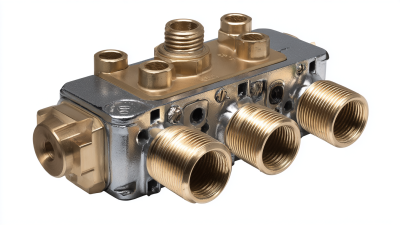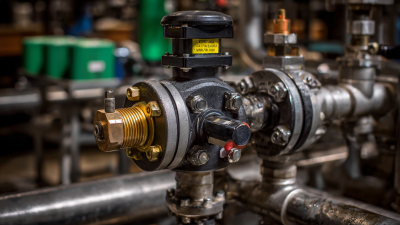In the ever-evolving landscape of industrial automation, the selection of the appropriate motorized valve is critical for optimizing system performance and reliability. According to a report from MarketsandMarkets, the global motorized valve market is projected to reach USD 8.8 billion by 2025, driven by the growing demand for efficient process control systems across various industries such as oil and gas, water and wastewater, and power generation. As technology advances, the complexity of these systems increases, making it essential for engineers and facility managers to understand the key factors that influence the selection of motorized valves. This blog outlines seven essential tips to guide you in choosing the right motorized valve for your system, ensuring operational efficiency and longevity.

When selecting a motorized valve for your system, understanding the various types is crucial. Motorized valves come in different designs, including electric, pneumatic, and hydraulic types, each tailored to specific applications. Electric valves are ideal for precise control in HVAC and industrial processes, while pneumatic valves are often utilized in systems requiring quick response times. Hydraulic valves, on the other hand, are effective in high-pressure environments, making them suitable for heavy machinery operations.
When choosing the right motorized valve, consider the application requirements and environmental conditions. For example, in high-temperature scenarios, ensure that the valve material can withstand thermal stress. Additionally, understanding the flow control needs of your system can guide you to the appropriate valve size and type.
Another essential tip is to evaluate the valve's compatibility with your existing system's control mechanisms. This compatibility ensures seamless integration and efficient operation, minimizing the likelihood of system disruptions. By focusing on these factors, you can make an informed decision that enhances the performance of your system.
| Valve Type | Actuation Method | Common Applications | Key Considerations | Advantages |
|---|---|---|---|---|
| Electric Actuated Valve | Electric Motor | Water Treatment, HVAC Systems | Power Source, Control System Compatibility | Precise Control, Quick Operation |
| Pneumatic Actuated Valve | Compressed Air | Industrial Processes, Chemical Handling | Air Supply, Leakage Potential | Rapid Response, Low Cost |
| Hydraulic Actuated Valve | Hydraulic Fluid | Heavy Machinery, Oil and Gas | Fluid Compatibility, Maintenance Needs | High Force, Compact Size |
| Manual Valve | Hand Operated | Simple Systems, Maintenance Lockout | Operator Accessibility, System Integration | Cost Effective, Reliable |
| Servo Actuated Valve | Feedback Control System | Automated Systems, Process Control | System Feedback, Electrical Supply | Highly Accurate, Programmable |
When selecting motorized valves, understanding key performance metrics is crucial for ensuring optimal function within your system. One of the primary metrics to consider is the actuator speed, which refers to how quickly the valve can open or close. This parameter is vital for applications where rapid response times are essential, such as in throttling scenarios or process control systems. A valve with the right actuator speed can significantly enhance your system's efficiency and responsiveness.
Another essential metric is torque requirements. Knowing the torque needed to operate the valve accurately allows you to choose an actuator that can handle the specific demands of your application. Oversized actuators can lead to unnecessary energy consumption, while undersized ones may not provide optimal performance or lead to premature wear and failure. Additionally, pressure ratings and environmental factors, such as temperature and corrosion resistance, should also be assessed to ensure the long-term reliability of the motorized valve in its intended application. By carefully evaluating these performance metrics, you can make a more informed decision that aligns with your system's needs.

When selecting the right motorized valve for your system, evaluating material compatibility is crucial for ensuring long-term reliability. A recent study highlights the importance of material performance, particularly in high-stress applications such as hydrogen energy equipment. The review on hydrogen-induced swelling in rubber composites illustrates that the choice of sealing materials can significantly affect the durability and effectiveness of valves exposed to hydrogen environments. Understanding these mechanisms is essential in avoiding premature failures and maintaining system integrity.
Furthermore, standards like the ISA-75 series emphasize the necessity of selecting materials that can withstand operational demands while ensuring safety and efficiency. For instance, the structural stability of composite heart valve prostheses demonstrates that materials subjected to millions of cycles can maintain performance without significant degradation. This resilience is vital not only in medical applications but across various industries where reliability and longevity of motorized valves are paramount. Therefore, careful consideration of material compatibility and performance metrics is essential in creating a robust and dependable motorized valve system.

The integration of automation and control systems plays a pivotal role in enhancing the efficiency of motorized valves. These advanced systems offer precise control over valve operations, allowing for real-time adjustments based on fluid dynamics, pressure changes, and system requirements. By leveraging automation, operators can optimize flow rates and minimize energy consumption, resulting in significant cost savings. Moreover, automated systems often feature remote monitoring capabilities, enabling users to track performance metrics and proactively address potential issues before they escalate, thereby improving overall reliability and uptime.
Additionally, the synergy between motorized valves and control systems enhances process safety and accuracy. Automated control loops can quickly react to deviations in system parameters, ensuring that valves open or close as needed to maintain desired conditions. This responsiveness is crucial in industries where fluid handling is sensitive to pressure fluctuations or temperature changes. Ultimately, by selecting the right motorized valve that is compatible with robust automation technologies, organizations can achieve a higher level of operational efficiency, ensuring their systems run smoothly and effectively.
When selecting motorized valves, understanding industry standards and certifications is crucial to ensure quality and reliability in your system. These standards not only provide a benchmark for performance but also enhance the safety and efficiency of your operations. Key certifications to look for include ISO 9001, which indicates that the manufacturer adheres to a quality management system, and CE marking, which signifies compliance with European health, safety, and environmental protection standards.
Additionally, consider valves that meet specific industry guidelines such as ANSI or API standards, which denote adherence to rigorous testing and quality assurance processes. These certifications can help you mitigate risks, reduce maintenance costs, and prolong the lifespan of the valves in your application. Investing in motorized valves that meet recognized industry standards can ultimately lead to better performance and greater peace of mind regarding system integrity.
This chart represents the essential factors to consider when selecting a motorized valve, rated on a scale from 1 to 10 in terms of importance. Ensuring quality in motorized valves involves understanding these key aspects.






Accreditations
ISO 9001 Quality Management
HSE Management Compliant
Products and services comply with relevant Australian (AS) and international (ISO, etc.) Standards.
"*" indicates required fields